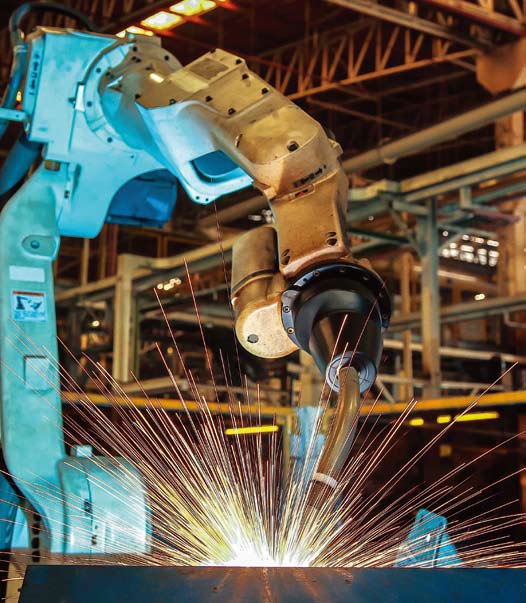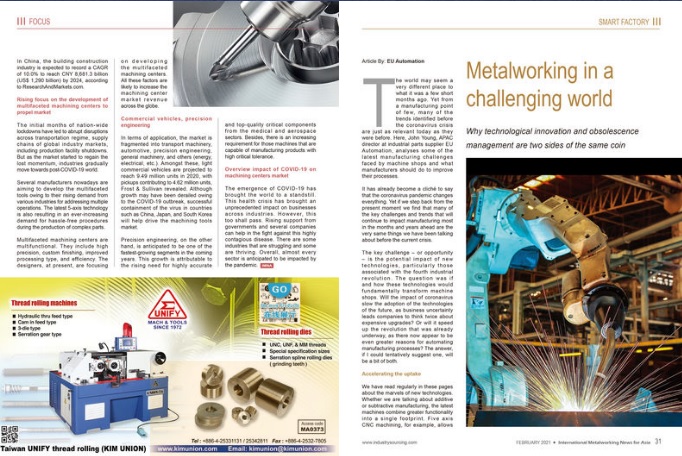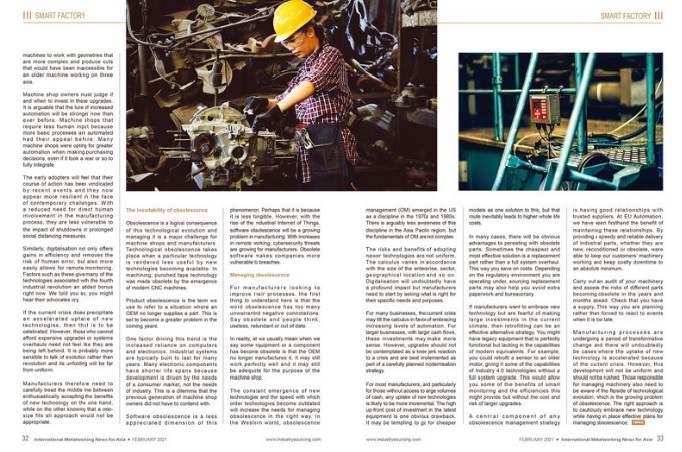Article By: EU Automation
The world may seem a very different place to what it was a few short months ago. Yet from a manufacturing point of few, many of the trends identified before the coronavirus crisis are just as relevant today as they were before. Here, John Young, APAC director at industrial parts supplier EU Automation, analyses some of the latest manufacturing challenges faced by machine shops and what manufacturers should do to improve their processes.
It has already become a cliché to say that the coronavirus pandemic changes everything. Yet if we step back from the present moment we find that many of the key challenges and trends that will continue to impact manufacturing most in the months and years ahead are the very same things we have been talking about before the current crisis.
The key challenge – or opportunity – is the potential impact of new technologies, particularly those associated with the fourth industrial revolution. The question was if and how these technologies would fundamentally transform machine shops. Will the impact of coronavirus slow the adoption of the technologies of the future, as business uncertainty leads companies to think twice about expensive upgrades? Or will it speed up the revolution that was already underway, as there now appear to be even greater reasons for automating manufacturing processes? The answer, if I could tentatively suggest one, will be a bit of both.

Accelerating the uptake
We have read regularly in these pages about the marvels of new technologies. Whether we are talking about additive or subtractive manufacturing, the latest machines combine greater functionality into a single footprint. Five axis CNC machining, for example, allows machines to work with geometries that are more complex and produce cuts that would have been inaccessible for an older machine working on three axis.
Machine shop owners must judge if and when to invest in these upgrades. It is arguable that the lure of increased automation will be stronger now than ever before. Machine shops that require less human input because more basic processes are automated had their appeal before. Many machine shops were opting for greater automation when making purchasing decisions, even if it took a year or so to fully integrate.
The early adopters will feel that their course of action has been vindicated by recent events and they now appear more resilient in the face of contemporary challenges. With a reduced need for direct human involvement in the manufacturing process, they are less vulnerable to the impact of shutdowns or prolonged social distancing measures.
Similarly, digitalisation not only offers gains in efficiency and removes the risk of human error, but also more easily allows for remote monitoring. Factors such as these give many of the technologies associated with the fourth industrial revolution an added bonus right now. We told you so; you might hear their advocates cry.
If the current crisis does precipitate an accelerated uptake of new technologies, then that is to be celebrated. However, those who cannot afford expensive upgrades or systems overhauls need not feel like they are being left behind. It is probably more sensible to talk of evolution rather than revolution and its unfolding will be far from uniform.
Manufacturers therefore need to carefully tread the middle line between enthusiastically accepting the benefits of new technology on the one hand, while on the other knowing that a one-size fits all approach would not be appropriate.

The inevitability of obsolescence
Obsolescence is a logical consequence of this technological evolution and managing it is a major challenge for machine shops and manufacturers. Technological obsolescence takes place when a particular technology is rendered less useful by new technologies becoming available. In machining, punched tape technology was made obsolete by the emergence of modern CNC machines.
Product obsolescence is the term we use to refer to a situation where an OEM no longer supplies a part. This is set to become a greater problem in the coming years.
One factor driving this trend is the increased reliance on computers and electronics. Industrial systems are typically built to last for many years. Many electronic components have shorter life spans because development is driven by the needs of a consumer market, not the needs of industry. This is a dilemma that the previous generation of machine shop owners did not have to contend with.
Software obsolescence is a less appreciated dimension of this phenomenon. Perhaps that it is because it is less tangible. However, with the rise of the Industrial Internet of Things, software obsolescence will be a growing problem in manufacturing. With increases in remote working, cybersecurity threats are growing for manufacturers. Obsolete software makes companies more vulnerable to breaches.
Managing obsolescence
For manufacturers looking to improve their processes, the first thing to understand here is that the word obsolescence has too many unwarranted negative connotations. Say obsolete and people think, useless, redundant or out of date.
In reality, all we usually mean when we say some equipment or a component has become obsolete is that the OEM no longer manufactures it. It may still work perfectly well and it may still be adequate for the purpose of the machine shop.
The constant emergence of new technologies and the speed with which older technologies become outdated will increase the needs for managing obsolescence in the right way. In the Western world, obsolescence management (OM) emerged in the US as a discipline in the 1970s and 1980s. There is arguably less awareness of this discipline in the Asia Pacific region, but the fundamentals of OM are not complex.
The risks and benefits of adopting newer technologies are not uniform. The calculus varies in accordance with the size of the enterprise, sector, geographical location and so on. Digitalisation will undoubtedly have a profound impact but manufacturers need to start by asking what is right for their specific needs and purposes.
For many businesses, the current crisis may tilt the calculus in favor of embracing increasing levels of automation. For larger businesses, with larger cash flows, these investments may make more sense. However, upgrades should not be contemplated as a knee jerk reaction to a crisis and are best implemented as part of a carefully planned modernisation strategy.
For most manufacturers, and particularly for those without access to large volumes of cash, any uptake of new technologies is likely to be more incremental. The high up-front cost of investment in the latest equipment is one obvious drawback. It may be tempting to go for cheaper models as one solution to this, but that route inevitably leads to higher whole life costs.
In many cases, there will be obvious advantages to persisting with obsolete parts. Sometimes the cheapest and most effective solution is a replacement part rather than a full system overhaul. This way you save on costs. Depending on the regulatory environment you are operating under, sourcing replacement parts may also help you avoid extra paperwork and bureaucracy.
If manufacturers want to embrace new technology but are fearful of making large investments in the current climate, then retrofitting can be an effective alternative strategy. You might have legacy equipment that is perfectly functional but lacking in the capabilities of modern equivalents. For example, you could retrofit a sensor to an older motor, giving it some of the capabilities of Industry 4.0 technologies without a full system upgrade. This would allow you some of the benefits of smart monitoring and the efficiencies this might provide but without the cost and risk of larger upgrades.
A central component of any obsolescence management strategy is having good relationships with trusted suppliers. At EU Automation, we have seen firsthand the benefit of maintaining these relationships. By providing a speedy and reliable delivery of industrial parts, whether they are new, reconditioned or obsolete, were able to keep our customers’ machinery working and keep costly downtime to an absolute minimum.
Carry out an audit of your machinery and assess the risks of different parts becoming obsolete in the years and months ahead. Check that you have a supply. This way you are planning rather than forced to react to events when it is too late.
Manufacturing processes are undergoing a period of transformative change and there will undoubtedly be cases where the uptake of new technology is accelerated because of the current crisis. However, this development will not be uniform and should not be rushed. Those responsible for managing machinery also need to be aware of the flipside of technological evolution, which is the growing problem of obsolescence. The right approach is to cautiously embrace new technology while having in place effective plans for managing obsolescence.
E-zine: Metalworking in a challenging world
\















